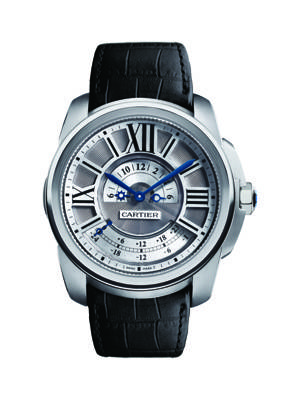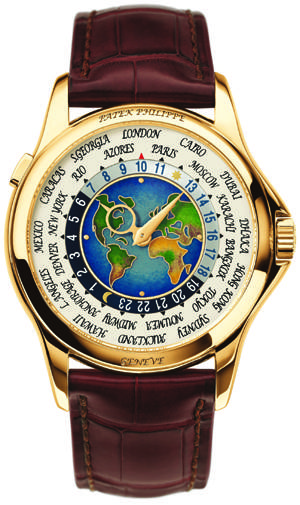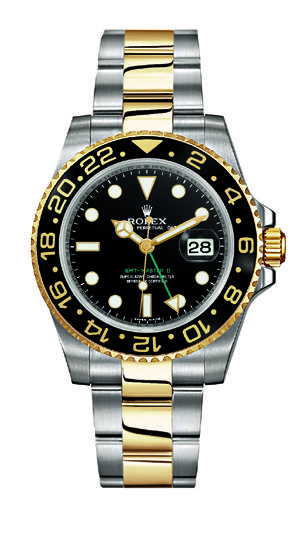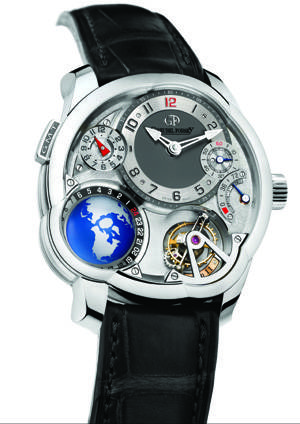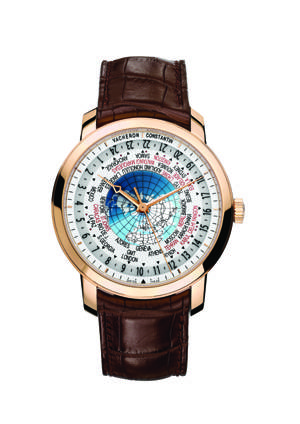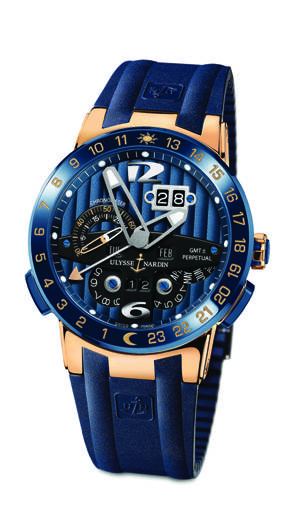They’re the traveler’s best friend–world time watches and their near-cousins, two time zone watches. They are designed to help jet-setters keep track of local time and the time in one or more other time zones. Their invention and development follows the evolution of travel itself, as a multiple time zone watch depends on the existence of a time zone system, and thereby hangs a tale.
The time zone system came to fruition because, before its invention, clocks and watches were set to local time. Originally, one would set their clock or watch to a sundial, but since the time on a sundial is different for every longitude (either a little or a lot, depending on the distance between any two points,) every city ran on a schedule slightly different than its neighbors. This was a non-issue until the development of the first national railway networks, when it became clear that having a different time standard for every city was guaranteed to result in wrecked trains and mangled bodies. In the late 1800s, various systems were proposed to bring order to chaos. Great Britain adopted a stopgap system by making Greenwich Mean Time the standard for railroads in 1847. The first true time zone system to gain widespread acceptance, however, was one proposed by Sir Sanford Fleming, a Canadian who divided the world into 24 time zones. Each time zone corresponded with fifteen degrees of longitude, making his plan officially accepted by the International Meridian Conference in 1884. By the end of the 1920s, most of the world was on a standard time zone system based on Fleming’s plan.
Today, the jet lagged traveler who wants to stay oriented to both local and home time has a bewildering variety of timepieces to choose from. These choices boil down to two types: world time watches and dual time zone watches. World time watches show the local time, while also showing the time in multiple time zones. This is made possible through the use of a rotating dial with 24 or more divisions on it, along with the names of reference cities for each time zone that are printed around the 24 hour indicator. A classic example is by Patek Philippe, whose current world time watches (references 5130 and 5131, in various metals, and with the option for an exquisite hand-painted enamel dial with a map of the earth,) are based on a system first developed in the 1930s by Genevan master watchmaker Louis Cottier. The Cottier system has the advantage of giving an instant overview of the time in every major time zone in the world. With this, however, companies making Cottier-style world time watches face challenges.
The first of these is that local time changes according to whether or not a given country in a particular time zone uses summer and winter time, as many Asian and African nations do not. The second problem is that it is challenging for world time watches to actually include all time zones. In addition to the 24, which have one-hour offsets from Greenwich Mean Time, there are a plethora of time zones with half hour and even quarter hour offsets. Most world time watches therefore simply stick with 24, accepting incompleteness as the price of legibility and practicality.
The third problem is that time zones are established by national statute, not by nature, which means that if a country decides to change its time zone system, a world time watch runs the risk of becoming outdated. All it takes, for instance, is a fit of pique on the part of a politician to create a new time zone. This was seen when Hugo Chavez notoriously established a new four and a half hour offset from GMT in 2007.
In contrast, dual time zone watches (which are sometimes called GMT watches after the habit of those pilots who use them for keeping the second time zone hand on Greenwich Mean Time, the standard for air navigation) sacrifice comprehensiveness for legibility and ease of use. Instead of showing the time around the world, a dual time zone watch simply uses a second hour hand, or in some cases, a sub-dial with a separate hour and minute hand to show the time in another time zone. While a dual time zone watch does not offer the kind of God’s-eye view of time around the globe that a world time watch does, they are usually easier to read to even the most confused and jet lagged traveler. The best watches have a system for moving the local time hand in discreet, one-hour jumps to avoid stopping the watch in order to set it.
Whether it’s the simplicity and ease of use of a dual time zone watch, or the philosophical appeal of a world timer, today’s globetrotters have a greater choice than ever before in finding a way to tell time that suits their up-in-the-air lifestyle.
The Calibre de Cartier Multiple Time Zone Watch
White gold, $56,000
Now that we’ve made things easy by saying there are just two kinds of watches for travelers (world time and dual time) we’re going to mix it up with a watch that’s a bit of both. Fortunately, this is no careless mash-up. It is a very carefully thought out timepiece from Cartier’s chief watch designer, renowned watchmaker Carole Forestier-Kasapi. Reading the watch is simplicity in itself. Home time is shown in a 12-hour sub-dial in the center of the watch with a double tailed hand. One end has a sun and the other a moon, showing AM or PM and local time by the two heat blued main hands on the dial. The pusher for changing the local time hour hand is cleverly integrated into the upper crown guard. The world time flavor comes via a sapphire window on the side of the case that shows a reference city for each of the 24 major time zones. This feature also shows offsets for summer and winter, for those reference cities where summer/winter time is in use, such as Paris and New York. The final fillip is the indication on the dial between the 4:00 and 8:00 positions, a “jet lag” indicator that shows the number of hours difference between home and local time.
The production of enamel dial watches is a specialty of Patek that has earned the watchmaker fame.
The Patek Philippe ref. 5131 World Time Watch with Enamel Dial
Yellow gold, $65,500; white gold $68,000
Patek Philippe’s modern reference 5130 and 5131 world time watches have a lineage tracing back to the 1930s, making them some of the most coveted and collected watches in the world. In 2002, a unique platinum model from 1939 sold at auction for over $4 million. The reference 5130 and 5131 timepieces are considered classics of the world time genre, offering a view of the time in 24 time zones with the beautiful observatoire-style hands that Patek has used on world time watches since the 1930s. Inside, is the lavishly hand decorated and ultra-flat micro-rotor automatic movement calibre 240 HU. The two flavors are the more discreet 5130 in white gold, rose gold or for real stealth luxury lovers, platinum. The critic’s darling is the ref. 5131 with its stunning cloisonné enamel dial. The production of enamel dial watches is a specialty of Patek that has earned the watchmaker fame.
The Rolex GMT-Master II
$11,750
The GMT-Master II sets the standard for dual time watches in terms of robustness, ease of use and legibility. It’s as purely functional a dual time watch as there is: hour, minute, sweep seconds hand and date, with a rotating 24-hour bezel to allow the time in a third time zone to be shown if desired. And it’s got real-world street cred to burn. The original GMT-Master was made by Rolex in collaboration with Pan Am in the 1950s for their pilots, and the watch proved so attractive that Pan Am executives had to be admonished not to purloin watches intended for pilots. Changing the time zone on today’s GMT-Master II is simple: just pull out the crown until the first stop and the hour hand can easily be set forward or backwards in one hour increments without disturbing the seconds hand and disrupting timekeeping.
The Greubel Forsey GMT
$650,000
It has a simple name, but this is a highly complicated–and highly exotic–timepiece. Greubel Forsey makes only a few hundred watches a year, all of which are tourbillons and made with an absolute disregard for any criterion other than perfection. Every component is finished to a degree that makes them among the most coveted watches in the world, as well as one of the most exclusive in price. It takes a cool quarter million U.S. dollars to even think about becoming a Greubel Forsey client. In this case, however, you get what you pay for. The GMT incorporates Greubel Forsey’s signature inclined tourbillon, a special adaptation of the tourbillon, which was originally designed for pocket watches. This adaptation allows it to provide the same advantages in accuracy in a wristwatch as it does in a pocket watch. The GMT also boasts a stunning titanium globe showing the Earth as it would be seen from space, if you were hovering above the North Pole. On the back, a uniquely designed 24 time zone city indicator allows you to easily compensate for Summer time offsets. And when it comes to accuracy, Greubel Forsey delivers. A Greubel Forsey tourbillon recently took first prize at the International Concours de Chronometrie, the world’s only open accuracy competition for wristwatches.
The Vacheron Constantin Patrimony Traditionnelle World Time
$48,900
The world time debate has a noble history at Vacheron Constantin. Vacheron Constantin, like its rival Patek Philippe, fielded the complication in wristwatches using the Cottier system. Its first Cottier-made world time watch dates to 1932. Vacheron famously has been doing business continuously since 1755, and in 2011, the world time watch returned to Vacheron Constantin in a spectacular fashion. Unlike most world time watches, which show only the 24 major time zones, the Patrimony Traditionnelle World Time wristwatch sports a new movement. This movement allows it to show all 37 time zones, even those with half hour and 15 minute offsets from Greenwich Mean Time. A sophisticated mechanism allows not only the hour hand, but also the minute hand, to jump to the correct time for any of the time zones shown. The movement was deliberately engineered in the event that any of the nations shown change their time zone system. The movement can be modified by Vacheron and supplied with an upgraded dial, so that the watch will always reflect geopolitical reality.
The Ulysse Nardin “Blue Toro” Perpetual Calendar Dual Time
$56,500
It’s a relative newcomer to the lineup of watches from Ulysse Nardin, one of fine watchmaking’s most distinguished independent firms. The company is renowned for its famous “Freak” wristwatch, which revolutionized watch design when it was introduced at the dawn of the 21st century. It is also recognized for its exotic and intelligently designed complications, including the world’s first perpetual calendar in which all indications could be set using only the crown. The world time watch and the perpetual calendar are a natural match. This watch, which always shows the correct date and automatically corrects itself for leap years, is the perfect pairing with a dual time display. Ulysse Nardin incorporates both of these features in the “Blue Toro” Perpetual Calendar Dual Time. The Blue Toro also boasts a big date display, which makes it one of the most useful traveler’s timepieces in the world. The bonus: using the case pushers to set the hour hand to a new local time automatically corrects all indications of the perpetual calendar as well.
The “Blue Toro” is a limited edition and exclusively sold at Ulysse Nardin Boutiques.







